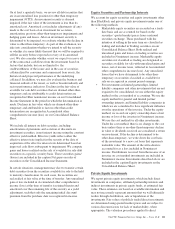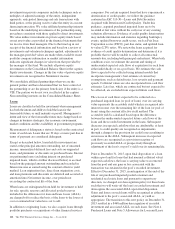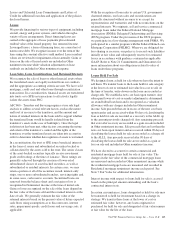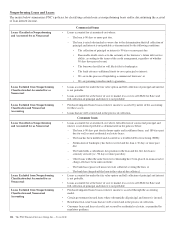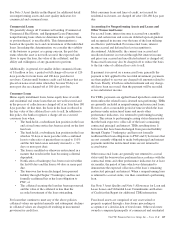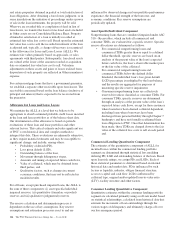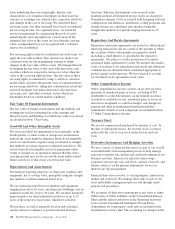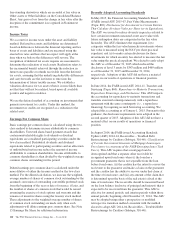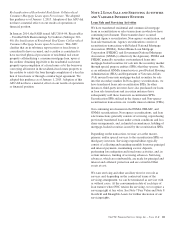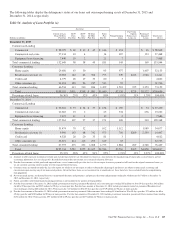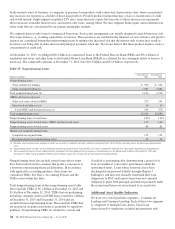PNC Bank 2015 Annual Report Download - page 138
Download and view the complete annual report
Please find page 138 of the 2015 PNC Bank annual report below. You can navigate through the pages in the report by either clicking on the pages listed below, or by using the keyword search tool below to find specific information within the annual report.
free-standing derivatives which are recorded at fair value in
Other assets or Other liabilities on the Consolidated Balance
Sheet. Any gain or loss from the change in fair value after the
inception of the commitment is recognized in Noninterest
income.
Income Taxes
We account for income taxes under the asset and liability
method. Deferred tax assets and liabilities are determined
based on differences between the financial reporting and tax
bases of assets and liabilities and are measured using the
enacted tax rates and laws that we expect will apply at the
time when we believe the differences will reverse. The
recognition of deferred tax assets requires an assessment to
determine the realization of such assets. Realization refers to
the incremental benefit achieved through the reduction in
future taxes payable or refunds receivable from the deferred
tax assets, assuming that the underlying deductible differences
and carryforwards are the last items to enter into the
determination of future taxable income. We establish a
valuation allowance for tax assets when it is more likely than
not that they will not be realized, based upon all available
positive and negative evidence.
We use the deferral method of accounting on investments that
generate investment tax credits. Under this method, the
investment tax credits are recognized as a reduction to the
related asset.
Earnings Per Common Share
Basic earnings per common share is calculated using the two-
class method to determine income attributable to common
shareholders. Unvested share-based payment awards that
contain nonforfeitable rights to dividends or dividend
equivalents are considered participating securities under the
two-class method. Distributed dividends and dividend
equivalents related to participating securities and an allocation
of undistributed net income reduce the amount of income
attributable to common shareholders. Income attributable to
common shareholders is then divided by the weighted-average
common shares outstanding for the period.
Diluted earnings per common share is calculated under the
more dilutive of either the treasury method or the two-class
method. For the diluted calculation, we increase the weighted-
average number of shares of common stock outstanding by the
assumed conversion of outstanding convertible preferred stock
from the beginning of the year or date of issuance, if later, and
the number of shares of common stock that would be issued
assuming the exercise of stock options and warrants and the
issuance of incentive shares using the treasury stock method.
These adjustments to the weighted-average number of shares
of common stock outstanding are made only when such
adjustments will dilute earnings per common share. See Note
15 Earnings Per Share for additional information.
Recently Adopted Accounting Standards
In May 2015, the Financial Accounting Standards Board
(FASB) issued ASU 2015-07, Fair Value Measurements
(Topic 820): Disclosures for Investments in Certain Entities
That Calculate Net Asset Value per Share (or its Equivalent).
The ASU was issued to reduce diversity in practice related to
how certain investments measured at net asset value with
future redemption dates are categorized in the fair value
hierarchy. The ASU eliminates the requirement (i) to
categorize within the fair value hierarchy investments whose
fair value is measured using the NAV per share practical
expedient, and (ii) to make certain disclosures for those
investments for which an entity has elected to measure the fair
value using the practical expedient. We elected to early adopt
the ASU as of December 31, 2015 which reduced the
disclosure of level 3 assets by $347 million and $469 million
as of December 31, 2015 and December 31, 2014,
respectively. Adoption of this ASU did not have a material
impact on our results of operations or financial position.
In June 2014, the FASB issued ASU 2014-11, Transfers and
Servicing (Topic 860): Repurchase-to-Maturity Transactions,
Repurchase Financings, and Disclosures. This ASU impacts
the accounting for repurchase-to-maturity transactions and
transfers executed contemporaneously with a repurchase
agreement with the same counterparty (i.e., a repurchase
financing) by requiring secured borrowing accounting. We
adopted this accounting as of January 1, 2015. Pursuant to this
guidance, the disclosure requirements were adopted in the
second quarter of 2015. Adoption of this ASU did not have a
material effect on our results of operations or financial
position.
In August 2014, the FASB issued Accounting Standards
Update (ASU) 2014-14, Receivables – Troubled Debt
Restructurings by Creditors (Subtopic 310-40): Classification
of Certain Government-Guaranteed Mortgage Loans upon
Foreclosure (a consensus of the FASB Emerging Issues Task
Force). This ASU requires that a mortgage loan be
derecognized and that a separate other receivable be
recognized upon foreclosure when (i) the loan has a
government guarantee that is not separable from the loan
before foreclosure; (ii) the creditor has the intent to convey the
real estate to the guarantor and make a claim on the guarantee
and the creditor has the ability to recover under that claim at
the time of foreclosure; and (iii) any amount of the claim that
is determined upon the basis of the real estate is fixed at the
time of foreclosure. The receivable should be measured based
on the loan balance (inclusive of principal and interest) that is
expected to be recovered from the guarantor. This ASU is
effective for annual periods, and interim periods within those
annual periods, beginning after December 15, 2014. The ASU
may be adopted using either a prospective or modified
retrospective transition method consistent with the method
elected to adopt ASU 2014-04, Receivables – Troubled Debt
Restructurings by Creditors (Subtopic 310-40):
120 The PNC Financial Services Group, Inc. – Form 10-K



